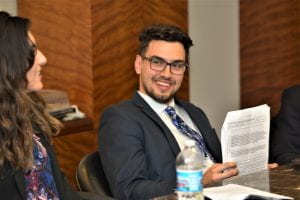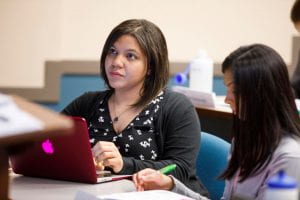 The role of the accountant has evolved over the years with the explosion of big data. Twenty years ago, companies didn’t have the technological capabilities they have today to capture the immense amounts of data that are now more accessible for use in organizational decision making. New tools and techniques also have automated many routine accounting tasks. The days of checking a small sample of data manually have been replaced by new technologies that can review millions of transactions from a single day automatically.
The role of the accountant has evolved over the years with the explosion of big data. Twenty years ago, companies didn’t have the technological capabilities they have today to capture the immense amounts of data that are now more accessible for use in organizational decision making. New tools and techniques also have automated many routine accounting tasks. The days of checking a small sample of data manually have been replaced by new technologies that can review millions of transactions from a single day automatically.
So what does this mean for new accounting professionals? What skills and experiences have become vital in a business world driven by big data? Over the last few years, the School of Accountancy & MIS has been addressing these questions and revising its curriculum to incorporate data analytics into its programs, learning opportunities and teaching methodologies.
Developing a Data Analytics Mindset
“We’ve followed something called the analytics maturity level,” says Associate Professor David Wang, who teaches data and audit analytics courses in DePaul’s audit and advisory master’s program. “We’ve basically designed courses at different levels so students can learn, in stages, the skills necessary to observe, read and analyze large amounts of data.”
The first level focuses on the descriptive, that is, making sure students are able to describe the data at hand. The second is diagnostic: teaching students how to identify and analyze patterns in the data and explain the meaning of the perceived patterns with actionable suggestions. Then come the predictive and prescriptive levels, where students provide predictions to help companies set goals and priorities, or prevent any number of undesirable outcomes.
The courses Wang teaches emphasize hands-on problem solving, with the goal of developing a student’s analytics mindset and data-driven decision skills.
“Analytics in accounting is about finding the patterns to support operational decisions,” says Wang. “A data scientist may not find a missing value to be a big deal, but for an accountant, a missing value can be a red flag. So, we try to teach students how to approach problems and interpret findings based on a company’s operational needs, rather than train them to be experts in a specific software or in the data itself.”

But the analytics mindset is not something you can train students to master in a 10-week course. Therefore, the school has students apply and practice what they’re learning in forensics, internal audit, data mining and other courses so the knowledge and skill sets are reinforced throughout the curriculum.
The school also hosts a scholarship-based data analytics case competition every year, another opportunity students can engage in to practice what they’re learning.
Working with the Data, Case by Case
Getting students comfortable with how to approach huge amounts of data has become one of the school’s biggest priorities, with a focus on more hands-on learning through the use of data analytics case studies and projects.
Ray Whittington, the school’s director, launched an initiative with Wang and other faculty members two summers ago to develop data analytics cases, including data sources, for faculty to weave into their courses. The goal is to create an in-house library of case studies in financial accounting, managerial accounting and auditing, and to allow the school to have uniform coverage of technology and data analytics across the curriculum. Backing this initiative is a grant from PwC.
“This was a proactive step in making sure our programs meet the demands of the market as well as the new accounting accreditation standards set by the AACSB,” says Whittington.
“As reaccreditation standards and the industry have evolved to emphasize data analytics, so has our approach to teaching and preparing students to tackle the new challenges and opportunities that accountants face today.”
Requiring students to write summaries of their conclusions when working on case studies is another element that’s been added to the curriculum. “It’s important that students are prepared to be able to professionally respond and present their solutions, as they would in a real-world setting,” adds Whittington.
Associate Professor Mary Mindak, who teaches financial reporting and auditing, worked with Whittington to develop one of the cases being used in auditing courses. The case calls for students to identify potential red flags and issues in the data using the analytics tool Tableau.
“It brings an element of real-world experience into the class, where students get to apply audit concepts and use analytics tools to help improve the audit and perform some analytical procedures,” says Mindak.
Software tools are an important component to learning how to analyze data, but not the most important, notes Mindak. “We make sure students understand the tools and get experience and exposure to them, but what’s really important is that they’re able to use their critical thinking and problem-solving skills no matter what tool they’re using, especially since the technology is always changing.”
Connecting Coursework to Real Work
The School of Accountancy & MIS regularly leverages industry connections to enhance student learning, and Wang has been doing just that in his graduate audit data analytics courses, creating opportunities for students to work directly with companies—such as Aon, the Federal Home Loan Bank of Chicago, Packaging Corporation of America (PCA) and others—on data analytics projects.
“I try to create a win-win situation,” says Wang. “I want students to be exposed to real business practices, be provided with networking opportunities and apply the coursework to a real project, and I want to help companies explore opportunities and processes that they may not have the internal resources to take on.”
Sometimes, says Wang, students have found job opportunities by working on these projects.
“The experience enhanced my consulting skills and technical understanding of data visualization,” says Tiffany McCoy, one of Wang’s students who participated in an audit analytics project with PCA in 2019. “It was an enlightening real-world application of fundamental course content.”
On that project, the student participants collaborated intensively with PCA’s internal audit team for three months before delivering a final presentation that offered actionable recommendations to PCA and creative ways to visualize analytics results.
“I always tell my students: accountants today are not just accumulating information and checking for errors,” says Wang. “We are in the business of helping companies analyze their data so we can help them increase efficiency, improve their strategies, problem-solve issues or generally help them attain goals. So, what kind of value are you going to provide a company? That value is what’s behind the analysis you do in your work.”
By Nadia Alfadel Coloma
